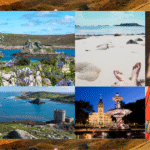Table of Contents
Introduction:

Alaska—the Last Frontier—is a dream destination for adventure seekers, nature lovers, and thrill enthusiasts. With its rugged landscapes, breathtaking wildlife, and endless outdoor activities, this majestic state offers experiences you won’t find anywhere else.
Whether you’re visiting for the first time or coming back for another epic journey, these three unforgettable outdoor adventures in Alaska, which we will cover in our Part 1 series, will leave you in awe!
Are you ready for the ultimate outdoor adventure? Look no further than Alaska, America’s largest and most rugged state. From breathtaking landscapes to incredible wildlife, Alaska is a nature lover’s paradise. In this ultimate guide, we’ll take you on a journey to discover the top outdoor adventures in Alaska in part-wise blog segments.
Alaska—where untamed wilderness meets breathtaking beauty and adventure knows no bounds. From towering glaciers to rugged mountain peaks, endless forests to pristine rivers, each Frontier is a dream destination for thrill-seekers, nature lovers, and trendy travel explorers alike.
Whether hiking through Denali National Park, kayaking alongside glaciers, or witnessing the mesmerizing northern lights, Alaska offers an adventure for every traveler. Our expert tips to help you make the most of your journey in one of the most awe-inspiring destinations on Earth.
The Ultimate Alaska Guide – Part 1
Alaska is a land of pure magic—a place where towering glaciers, untamed wildlife, and celestial wonders create an adventure like no other. If you’re craving an experience then this guide is your gateway to three unforgettable outdoor adventures that you can’t miss!
What we bring to the table via Part1 Alaska blog diary, here is a brief overview:
Glacier Hiking at Exit Glacier – Step onto the icy terrain of Exit Glacier, where you’ll trek across a frozen wonderland, witness stunning blue ice formations, and feel the thrill of walking on centuries-old glacial ice.
Wildlife Viewing in Denali National Park – Get up close (but not too close!) to Alaska’s iconic wildlife, including grizzly bears, moose, and caribou, all set against the stunning backdrop of North America’s tallest peak, Denali.
This is just the beginning of your ultimate Alaskan adventure! Get ready to explore, be amazed, and check off these once-in-a-lifetime experiences from your bucket list. Stay tuned for more absorbing facts in this thrilling series with travel solaces!
Get ready to embrace the wild, challenge your limits, and create memories that will last a lifetime.
Join us as we journey into the untamed beauty of Alaska, uncovering three must-visit destinations that deserve a top spot on your adventure bucket list!
1.Glacier Hiking in Exit Glacier!!

If you’ve ever dreamed of stepping onto a real glacier, feeling the crunch of ancient ice beneath your boots, and witnessing nature’s raw beauty up close—then Exit Glacier in Alaska is calling your name!
Located just outside Seward in Kenai Fjords National Park, this accessible yet thrilling glacier hike is an absolute must for any outdoor adventurer.
Are you ready to embark on an adventure of a lifetime? Look no further than glacier hiking in Exit Glacier, Alaska. Kenai Fjords National Park, Exit Glacier is one of Alaska’s most accessible glaciers, offering a unique and unforgettable hiking experience.
Why Visit Exit Glacier?
Exit Glacier is a must-visit destination for outdoor enthusiasts and nature lovers. Here are a few reasons why you should visit Exit Glacier:
Accessibility: Exit Glacier is one of the most accessible glaciers in Alaska, with a paved road leading right to the glacier’s toe.
Breathtaking Scenery: The glacier’s stunning blue ice and surrounding mountains offer thrilling scenery and photo opportunities.
Unique Hiking Experience: Glacier hiking is a unique and exhilarating experience allowing you to explore the glacier’s surface and witness its beauty up close.
Exit Glacier is one of the Most Accessible and frequently visited Glaciers in Alaska!
Unlike many glaciers that require a long trek or even a helicopter ride to reach, Exit Glacier is one of the few in Alaska where you can drive right up to the trailhead!
Whether you’re a seasoned hiker or a first-timer, this makes it a perfect spot to experience glacier hiking without extreme logistics and in-depth hiking knowledge.
A Front-Row Seat to a Changing Glacier!
Exit Glacier is one of the most famous flowing rivers of ice in the U.S., and it’s constantly changing.
It’s one of the few places where you can literally see the effects of climate shifts, with markers along the trail showing how much the glacier has receded over the years. It’s a humbling and eye-opening experience.
Jaw-Dropping Scenic Beauty!
Surrounded by towering peaks, lush forests, and cascading waterfalls, this hike offers more than just a glacier—it’s a full-on Alaskan wilderness experience. Plus, the contrast of vibrant blue ice against the rugged mountain backdrop makes for an insanely Instagram-worthy photo spot!
Why it’s amazing:
Walking on an ancient, slow-moving river of ice is an experience like no other! Exit Glacier, part of Kenai Fjords National Park, offers accessible glacier hikes with stunning blue ice formations and deep crevasses.
Kenai Fjords National Park:
Kenai Fjords National Park is a breathtaking paradise where glaciers, wildlife, and dramatic landscapes collide. Covering over 669,000 acres, this stunning park is home to Exit Glacier, the vast Harding Icefield, and countless fjords carved out by ancient glaciers.
History and Culture
Kenai Fjords National Park has a rich cultural and historical heritage, with evidence of human presence dating back thousands of years. The park is home to numerous archaeological sites and historical landmarks. Here are some notable archaeological sites and historical landmarks within or near the park.
Archaeological Sites & Indigenous History
Aialik Bay Archaeological Sites: Discover traces of ancient human history, including remnants of early Alaska Native settlements, once home to the Sugpiaq (Alutiiq) people and their enduring heritage.
Nuka Bay Archaeological Sites: Home to ancient coastal villages and historic hunting camps, this region reveals how Indigenous communities adapted and thrived in Alaska’s glacial landscape for millennia.
Agvik Site: A centuries-old site showcasing the remnants of prehistoric dwellings and tools once used by the Sugpiaq people for fishing and hunting marine mammals, offering a glimpse into their rich maritime heritage.
Chugach Sugpiaq Cultural Sites: These sites provide insight into the maritime lifestyle of the Sugpiaq (Alutiiq) people, who relied on fishing, whaling, and trade for survival.
Historical Landmarks & Notable Sites
Russian Settlements & Influence: While no major Russian-era structures remain within the park itself, Russian explorers and traders significantly impacted the region, and artifacts from Russian contact have been found in many archaeological digs.
Resurrection Bay & Seward: The nearby town of Seward (gateway to Kenai Fjords) has historical significance as a gold rush port, a hub for the Alaska Railroad, and a key site in early Alaskan exploration.
Harding Icefield: This vast icefield, named after President Warren G. Harding following his visit to Alaska in 1923, holds deep historical significance and is a crucial site for studying glaciers and ever-fluctuating climate change.
World War II Military Sites (Near the Park): While not directly inside the park, WWII bunkers and military relics can be found in the surrounding areas, such as Caines Head State Recreation Area near Seward, which played a role in coastal defense.
Conservation and Management
The National Park Service (NPS) carefully oversees the park, safeguarding its natural beauty and cultural heritage. With a mission to preserve its fragile ecosystem while ensuring a remarkable visitor experience, the NPS maintains a delicate balance between conservation and exploration.
Visiting Information
Location: Southern Alaska, near the town of Seward
Size: Approximately 670,000 acres
Established: 1980
Visitors: Over 300,000 per year
How to Experience Kenai Fjords National Park
Hike Exit Glacier: The most accessible way to see a glacier up close.
Take a Boat Tour: Witness calving glaciers and spot marine life in the fjords.
Go Kayaking: Paddle through pristine waters with jaw-dropping views.
Wildlife Watching: Look for orcas, humpback whales, bald eagles, and bears.
Flightseeing Tours: See the Harding Icefield from above for an unforgettable aerial perspective.
Fun Facts about Kenai Fjords National Park!!
Over 50% of the park is covered in ice!
The Harding Icefield is one of the largest ice fields in the U.S., spanning over 700 square miles.
Kenai Fjords is a prime destination to witness the awe-inspiring spectacle of glacier calving, where massive ice chunks break away and thunder into the ocean, creating a breathtaking display of nature’s power.
The park is named after the fjords formed by deep valleys carved by glaciers thousands of years ago.
Ideal Time to Visit: Experience Alaska’s endless summer days from June to August, perfect for warmer weather and outdoor adventures. For a winter wonderland, visit between December and March, when dog sledding and dazzling Northern Lights steal the show.
Walk on Ice that’s Thousands of Years Old – How often do you get the chance to walk across centuries of history? At Exit Glacier, every step takes you over ancient ice that has stood the test of time, offering a rare journey into the past.
Feel the Power of Nature – The sheer size of the glacier, the sound of cracking ice, and the crisp, pure air will make you realize just how wild and untamed Alaska truly is.
It’s an Epic Workout with Rewarding Views – The hike is moderately challenging, but the panoramic views at the top are worth every step! If you’re up for a more strenuous adventure, you can tackle the Harding Icefield Trail for an even more spectacular vantage point.
Harding Icefield Trail:
If you’re looking for one of the most breathtaking and rewarding hikes in Kenai Fjords National Park, the Harding Icefield Trail should be at the top of your list! This 8.2-mile (round-trip) trek takes you from lush forests to a spectacular viewpoint overlooking the vast Harding Icefield, one of the largest icefields in the United States.
Trail Description:
The trail begins in a forest of spruce and hemlock trees, before ascending through a series of steep switchbacks. As you climb higher, the trees give way to meadows and wildflowers, offering stunning views of the surrounding mountains. The trail eventually reaches the Harding Icefield, a vast expanse of ice that stretches as far as the eye can see.
Highlights and Features
Harding Icefield: The trail’s ultimate destination, the Harding Icefield is a breathtaking sight, with crevasses, seracs, and ice caves waiting to be explored.
Wildlife Viewing: Keep an eye out for wildlife, including bears, moose, and mountain goats.
Stunning Views: The trail offers breathtaking views of the surrounding mountains, glaciers, and fjords.
Unique Geology: The trail takes you through a variety of geological formations, including glacial moraines, rocky outcroppings, and ice caves.
Glacier Dynamics: Witness the glacier’s movement and change over time, with visible crevasses and seracs.
Wildlife Viewing: Keep an eye out for wildlife, including bears, moose, and mountain goats.
Challenges and Precautions
Steep Terrain: The trail is steep and challenging, with uneven terrain and rocky outcroppings.
Unpredictable Weather: The weather in Alaska can be unpredictable, with sudden changes in temperature, wind, and precipitation.
Glacier Travel: Traveling on glaciers can be hazardous, with crevasses, seracs, and ice caves posing a risk to hikers.
What to Expect on the Trail
Mile 0-1: Lush Forest & Exit Glacier Views
The hike starts at the Exit Glacier Nature Center, passing through a beautiful temperate rainforest with towering trees and occasional glimpses of Exit Glacier in the sighting distance.
Mile 1-2: Steep Climb & Alpine Meadows
The trail quickly ascends, revealing wildflower-filled meadows in summer and stunning panoramic views that can delight any traveler.
Mile 2-4: High Alpine Terrain & the Icefield Overlook
As you near the top, the landscape becomes rocky and barren, with snow patches lingering even in summer. Finally, you reach the Harding Icefield Overlook, where you’ll witness an endless sea of ice stretching and melting down to the horizon!
Regulations and Permits
Park Entrance Fee: A park entrance fee is required to access the trail.
Backcountry Permit: A backcountry permit is required for overnight camping in the park.
Glacier Travel Permit: A glacier travel permit may be required for travel on the Harding Icefield.
Preparation and Gear
Hiking Boots: Sturdy hiking boots with good tread and ankle support are essential for these trail hikes.
Crampons and Ice Axes: If you plan to travel on the glacier, be sure to bring crampons and ice axes to ensure guaranteed traction and safety.
Weather Gear: Bring layers, a waterproof jacket, a warm hat and gloves to prepare for unpredictable weather.
Bear Spray: Bear spray is a must-have in Alaska, where bears are common in this icy landscape.
Fun Facts about Harding Icefield!!
It’s one of the largest icefields in North America and has been around since the Pleistocene Era (over 10,000 years ago!).
Exit Glacier is just one of 40 glaciers fed by the Harding Icefield.
The ice can be up to 4,000 feet thick! That’s nearly as deep as three Empire State Buildings stacked on top of each other.
It was named after President Warren G. Harding, who visited Alaska in 1923.
Historical Significance: Exit Glacier has been the subject of scientific study and exploration for decades, offering a unique glimpse into Alaska’s natural history.
Researchers are drawn to this glacier due to its accessibility and rapid recession, which provides a unique opportunity to study the impacts of climate change.
Glaciology and Climate Change Research
Scientists are conducting studies on the glacier’s mass balance, ice flow, and calving dynamics to better understand the effects of climate change on glaciers. By monitoring the glacier’s retreat, researchers can gain insights into the impacts of rising temperatures on glacier health and sea-level rise.
Geology and Landscape Evolution
The Exit Glacier area is also a fascinating site for geological research. Scientists are studying the glacier’s role in shaping the surrounding landscape, including the formation of glacial features such as moraines, drumlins, and glacial lakes.
Ecological Research
As the glacier retreats, new habitats are being created, and scientists are studying the colonization of these areas by plants and animals. This research provides valuable insights into the complex relationships between glaciers, ecosystems, and climate change.
Other Areas of Exploration
In addition to these scientific studies, Exit Glacier is also an important area for:
Glacier hiking and ice climbing: Guided tours and adventure activities allow visitors to explore the glacier up close and experience its beauty and power.
Wildlife viewing: The area surrounding Exit Glacier is home to a variety of wildlife, including bears, moose, and mountain goats.
Education and outreach: The Exit Glacier Nature Center and ranger-led programs provide opportunities for visitors to learn about the glacier’s nature, its history, and its impacts on climate change.
Pro Tip:
Book a guided tour for a safer, more informative experience. Wear crampons for better grip on the ice!
Dress for the Elements: Even in summer, glaciers are cold! Wear moisture-wicking layers, a windproof jacket, and sturdy hiking boots with good grip. The weather in Alaska can be unpredictable, so be sure to pack layers and dress warmly.
Bring Crampons or Ice Cleats: If you plan on getting up close and personal with the glacier, these will help you avoid slipping on the icy surface.
Go with a Guide for the Full Experience: While you can explore parts of Exit Glacier on your own, guided tours take you safely onto the ice, where you’ll get to see deep crevasses, shimmering ice caves, and hidden features you’d otherwise miss.
Respect the Glacier: It’s tempting to get super close, but glaciers can be unpredictable. Stick to safe areas and follow ranger guidelines to protect both yourself and this natural wonder.
Hike with a Guide: Consider hiring a guide or joining a guided hike to ensure a safe and informative experience.
Bring Crampons and Ice Axes: If you plan to hike on the glacier, be sure to bring crampons and ice axes to ensure traction and safety.
Crampons and ice axes are essential tools for glacier travel, ice climbing, and other winter activities that involve traversing icy or hard snow surfaces.
Crampons
Crampons are metal spikes that attach to your boots or shoes, providing traction on icy or hard snow surfaces. They consist of:
Spikes: Sharp, pointed metal spikes that dig into the ice or snow.
Frame: A metal frame that holds the spikes in place.
Binding system: A system that attaches the crampons to your boots or shoes.
Crampons are used to:
Prevent slipping and falling on icy surfaces.
Provide stability and balance on uneven or slippery terrain.
Enable you to traverse steep or vertical ice surfaces.
Ice Axes
Ice axes are versatile tools used for balance, self-arrest, and anchoring on snow and ice. They consist of:
Head: The metal head of the axe, which includes the pick and axe.
Pick: The pointed end of the axe, is used for digging into ice.
Adze: The broad, flat end of the axe, used for chopping and anchoring.
Shaft: The handle of the axe, which can be made of wood, fiberglass, or carbon fiber.
Ice axes are used for:
Balance: To help with balance and stability on uneven or slippery terrain.
Self-arrest: To stop yourself from falling by digging the pick into the ice.
Anchoring: To create an anchor point for ropes or other equipment.
Using Crampons and Ice Axes Together
When traveling on glaciers or icy surfaces, it’s often necessary to use crampons and ice axes together. This combination provides:
Traction: Crampons provide traction on the ice, while the ice axe helps with balance and stability.
Security: The ice axe can be used for self-arrest or anchoring, providing an added layer of security.
Types of Crampons
Strap-on Crampons: Work with most hiking boots and are great for beginners.
Hybrid Crampons: Designed for stiff-soled boots; offer a balance between security and ease of use.
Step-in Crampons: Best for mountaineering; require specialized boots with toe and heel welts.
Pro Tips for Using Crampons:
Walk flat-footed to ensure all spikes grip the ice.
Avoid crossing your feet to prevent tripping on the spikes.
Pair with gaiters to keep snow out of your boots.
Exciting Fun Facts about Exit Glacier:
Glacier Size: Exit Glacier is approximately 8 miles long and 2 miles wide.
Glacier Movement: The glacier moves at a rate of about 1-2 feet per day.
Glacier Age: The ice at Exit Glacier is estimated to be around 400-500 years old.
Exit Glacier got its name because it was the “exit route” for explorers from the vast Harding Icefield.
You can hear the glacier “talk” as it shifts and moves! Glaciers constantly creak and groan as the ice compacts and melts. It’s a sound you’ll never forget.
Alaska is home to about 100,000 glaciers! Exit Glacier stands out as one of the most accessible and breathtaking glaciers to explore—no helicopter or boat is required.
Whether you’re snapping epic photos, learning about Alaska’s ever-changing landscape, or just soaking in the surreal beauty, this is one adventure you’ll be talking about for years to come.
Key Takeaways, Why Exit Glacier Needs to Be on Your Bucket List!!
Easy to reach: No helicopters or extreme trekking required!
Incredible natural beauty: Towering ice formations, deep blue crevasses, and epic mountain views.
A unique, bucket-list experience: Not many people can say they’ve walked on a glacier!
A glimpse into Earth’s history: Witness thousands of years of ice in a single step.
Perfect for all adventurers: Whether you want a relaxed scenic hike or a challenging trek, Exit Glacier delivers the ultimate thrill by fulfilling the passion of the adventurer’s dream.
Safety First: Always prioritize safety when hiking on a glacier, and consider hiring a guide if you’re unsure about trekking.
Respect the Environment: Always adhere to following guidelines and respect the glacier’s delicate ecosystem to help preserve its beauty for global sustainability.
Be Prepared: Pack accordingly, bring necessary gear, and be prepared for changing weather conditions where navigating the fear and conquering the dream of an enthusiastic adventurer are the ultimate requirements.
2.Wildlife Viewing in Denali National Park!!

Are you ready for a wildlife adventure of a lifetime?
Then Denali National Park in Alaska is going to fulfill your wildlife safari and adventure wanderlust. As one of the most spectacular national parks in the United States, Denali is home to an incredible array of wildlife, including grizzly bears, moose, caribou, wolves, and Dall sheep.
Alaska is a dream destination for adventure seekers, and if you’re looking for unforgettable wildlife encounters, Denali National Park is the place to be!
Spanning six million acres, this untamed wilderness is a sanctuary for North America’s most iconic wildlife set against the breathtaking backdrop of Denali—soaring at 20,310 feet famed as the continent’s highest peak.
Whether you’re a nature enthusiast, a wildlife photographer, or just someone who wants to experience Alaska’s untamed beauty, Denali National Park offers a front-row seat to the best wildlife viewing on the planet.
Why Visit Denali for Wildlife Viewing?
A Wildlife Wonderland
Denali is home to Alaska’s legendary Big Five:
Grizzly Bears – Roaming the tundra and riverbeds, these giants are often spotted from the park road.
Moose – The largest members of the deer family, often seen near marshy areas or along rivers.
Wolves – Elusive but thrilling to spot, Denali has one of the few protected wolf populations in the U.S.
Dall Sheep – Climbing the rugged cliffs, their white coats stand out against the rocky landscape.
Caribou – Large herds migrate through the park, offering stunning photo opportunities.
Birdwatcher’s Paradise
From golden eagles soaring above to ptarmigans blending into the tundra, bird lovers will be in heaven.
Pristine Wilderness
With no paved roads beyond Mile 15, Denali remains one of the most unspoiled landscapes in the U.S., giving visitors a true taste of the wild.
Unparalleled Wildlife Diversity: Denali is home to 39 species of mammals, 167 species of birds, and 10 species of fish.
Uncrowded Viewing Opportunities: Unlike other popular wildlife destinations, Denali offers a serene and peaceful viewing experience, with plenty of space to observe animals without the crowds.
Expert Guides and Rangers: Take advantage of guided tours and ranger-led programs to gain a deeper understanding of Denali’s incredible wildlife.
Best Ways to See Wildlife in Denali!
Take a Wildlife Bus Tour: Private vehicles aren’t allowed past Mile 15, so hop on a park bus for the best wildlife sightings.
Hike the Savage River Area: One of the best spots for seeing Dall sheep, moose, and caribou.
Camp in the Park: More time in nature means more chances to spot nocturnal wildlife.
Scenic Flights: Soar above Alaska’s rugged wilderness on a small plane or helicopter tour, offering a bird’s-eye view of breathtaking landscapes and wildlife from the skies!
Why it’s amazing:
Habitat Diversity: Denali’s diverse landscape, which includes tundras, forests, and mountains, supports a wide range of wildlife habitats.
Rich Food Supply: With an abundance of berries, salmon, and lush grasses, the park provides a thriving habitat that draws a diverse array of wildlife across its vast, untamed landscape.
Protected Environment: As a national park, Denali provides a protected environment for wildlife to thrive in their natural habitat.
Pro Tip:
Take a guided bus tour for the best chance to spot wildlife while learning about the park’s ecosystem. Private vehicles have limited access. Opt for a park-run bus tour for the best wildlife-spotting opportunities.
Bring Binoculars: A good pair of binoculars can help you spot wildlife from a distance. Many sightings are from a distance, and you’ll want to capture the moment. A good zoom lens will make a huge difference.
Be Patient: Wildlife viewing often requires patience, so be prepared to spend time waiting for wildlife to appear and observe it from a sighting distance.
Stay Safe: Keep a safe distance from wildlife and follow park rules and regulations.
Go Early or Late in the Day – Animals are most active at dawn and dusk.
Stay Quiet & Patient – Wildlife won’t come out if they sense loud human activity. Avoid loud noises that could scare wildlife away. Remember, you’re a visitor in their home!
Dress in Layers: Denali’s weather can change quickly, so be prepared to combat challenging weather conditions. Alaska’s weather is unpredictable, so layering is key.
Carry Bear Spray: Encounters are rare but always be prepared as the bear population is quite dense here! And you should be prepared how to react if you encounter one wildlife fearsome.
Respect the 300-Yard Rule: Keep a safe distance from bears and other large animals.
Fun Facts about Denali’s Wildlife!!
Moose can tower up to 7 feet at the shoulder—making them even taller than the average NBA player!
Grizzly bears eat up to 90 pounds of food per day in preparation for winter hibernation!
Wolves in Denali can roam over 500 square miles in search of food.
Golden eagles have a wingspan of up to 7 feet, almost as wide as a small car!
Denali caribou migrate hundreds of miles each year, making them one of Alaska’s great wanderers.
Denali National Park is larger than the state of New Jersey!
Grizzly Bears: Denali is home to a healthy population of grizzly bears, which can weigh up to 800 pounds.
Moose: Denali’s moose are the largest in the world, with antlers that can span up to 6 feet.
Caribou: The Park’s caribou herd is one of the largest in Alaska, with over 2,000 animals.
Moose are taller than horses; they can reach up to 7 feet tall at the shoulder!
Wolves roam free, unlike many parts of the U.S.; Denali has a healthy, self-sustaining wolf population.
Grizzly bears don’t hibernate as long here: Due to Denali’s short summer, grizzlies are extra active when awake.
Caribou have built-in snowshoes: Their hooves spread out to help them walk on snow and dig for food in winter.
Dall sheep are expert climbers: They scale near-vertical cliffs to escape predators.
Key Takeaways
Before you head out on your wildlife viewing adventure in Denali National Park:
Check Park Regulations: Familiarize yourself with park rules and regulations, including any restrictions on wildlife viewing.
Bring a Field Guide: A field guide can help you identify the different species of wildlife you encounter.
Wildlife Etiquette: Admire animals from a safe distance, respect their natural habitat, and never attempt to approach or feed them—let nature remain wild!
Denali National Park is one of the best places in the U.S. for wildlife viewing.
The park’s remote nature means a more authentic and uncrowded experience.
Seeing the Big Five is a dream that adds value to your bucket-list-worthy adventure.
Preparations are key know the best times, bring the right gear, and respect the wildlife.
Why You Should Visit Alaska Now!!
Alaska is one of the world’s last true frontiers, a pristine wilderness that promises once-in-a-lifetime adventures found in few places on Earth.
Whether you’re seeking adventure, tranquility, or simply jaw-dropping landscapes, Alaska has it all.
Book your trip, pack your gear, and prepare for the ultimate outdoor adventure!
Conclusion: The Ultimate Alaskan Adventure Awaits!
As we conclude our Ultimate Guide Part 1 Series, we hope you’re as stoked as we are about the endless outdoor adventures waiting for you in Alaska. From the breathtaking beauty of Exit Glacier to the incredible wildlife viewing opportunities in Denali National Park, Alaska is the ultimate destination for outdoor enthusiasts.
Glacier hiking in Exit Glacier offers a rare chance to walk on a living, ever-changing sheet of ice, while wildlife viewing in Denali connects you with some of North America’s most majestic creatures in their natural habitat.
Whether you’re drawn to the raw power of nature or the serenity of the Alaskan wilderness, these experiences are nothing short of magical.
The wild, untamed beauty of the 49th state is calling and trusts us; you don’t want to miss out!
Keep your adventurous spirit alive and stay tuned for the next chapter of our Ultimate Guide- you won’t want to miss what’s coming next in our blog series!
FAQs:
What is the best time to visit Alaska for outdoor adventures?
The best time to visit Alaska for outdoor adventures depends on the activity. From June to August, summer offers the perfect setting for hiking, wildlife spotting, and kayaking, while winter, from December to March, transforms Alaska into a wonderland for dog sledding, skiing, and witnessing the mesmerizing Northern Lights.
What’s the best time of year to hike Exit Glacier?
The best time is from June to early September when the weather is milder and trails are accessible. Outside of this window frame, ice conditions can be unpredictable to combat.
How do I get to Exit Glacier?
Exit Glacier is located in Kenai Fjords National Park, about 10 miles from Seward. You can drive to the glacier or take a shuttle bus from Seward.
How long does a wildlife viewing trip in Denali National Park typically take?
Wildlife viewing trips in Denali National Park can vary, from a few hours to a full day. The length of the trip will depend on the type of wildlife you want to see and the time of year you visit.
Can I visit Denali and Exit Glacier on one trip?
Definitely! Many travelers combine both in one itinerary. Denali is about a 4.5-hour drive from Anchorage, while Exit Glacier is in Kenai Fjords National Park near Seward. Plan at least a week to enjoy both the places with freedom and joy!







